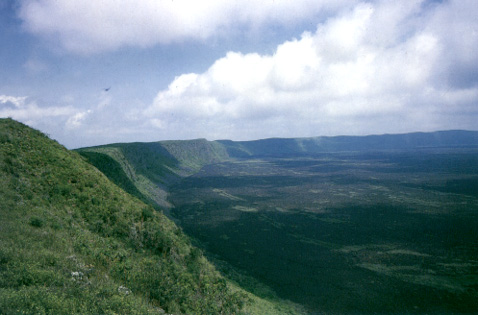|
Description of the Galapagos Islands Isla Sierra Negra  | | Isla Sierra Caldera. Picure source: http://www.geo.cornell.edu/geology/GalapagosWWW/SierraNegra.html |
Sierra Negra rises to an elevation of nearly 1500 meters (4890 feet) and is located in the southeast of Isla Isabela, (or Albermarle Island). It is the largest and one of most active volcanos in the archipelago, with 10 known eruptions since 1813, the most recent in 1979. Over ninety percent of the surface of the volcano is younger than 4500 yrs, judging from cosmic ray exposure ages of lavas. Though Sierra Negra shares a number of characteristics with the other large western Galapagos volcanos, such as steep upper slopes that give it an "inverted soup-bowl" shape, it does differ in several respects. First, its slopes are somewhat gentler, and its has a broader coastal apron than those of its neighbors; second, there is a prominent rift system that runs from northeast to southwest which deflects around the caldera. In this respect it is similar to the Hawaiian volcanos, which also have prominent rift systems. As in Hawaii, many of the eruptive vents on Sierra Negra are located along the rift. The 1979 lava flow erupted from a vent called Volcan Chico, located along the rift just to the northeast of the caldera.
Sierra Negra's caldera is somewhat unusual as well. It is elliptical, with its long axis aligned northeast southwest, whereas calderas on the other western volcanos are nearly circular. At 7 by 10 km, it has easily the largest caldera in the Galapagos. At is 100 and 140 m deep, is also the shallowest caldera. The caldera is structurally complex and has clearly collapsed in several stages. Much of the caldera floor is covered by quite young lava flows.
The composition of Sierra Negra's lavas are quite uniform, yet they differ markedly, particularly in trace element abundances from it that of its neighbor to the north, Volcan Alcedo. Thus they neighboring volcanos derive there magma from distinct areas of the the mantle through different plumbing systems. Sierra Negra is, however, compositionally similar to it western neighbor, Cerro Azul, which is currently erupting. It is concievable that magma feeding these two volcanos is derived from a common melting zone in the mantle.
The southern flank of Sierra Negra is the windward side and often bathed in clouds and mist. As a result, it is heavily vegetated. This area is the site of two of the oldest settlements in the Galapagos, the coastal village of Villamil and the town of Santo Tomas, located 20 km inland high on the flank of the volcano. Santo Tomas was orginally established to mine sulfur from the fumeroles in the area. Some cattle and goat ranching occurs on the southern slopes, and there are many feral cattle and goats as well.
|







